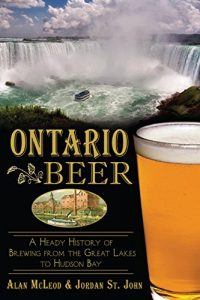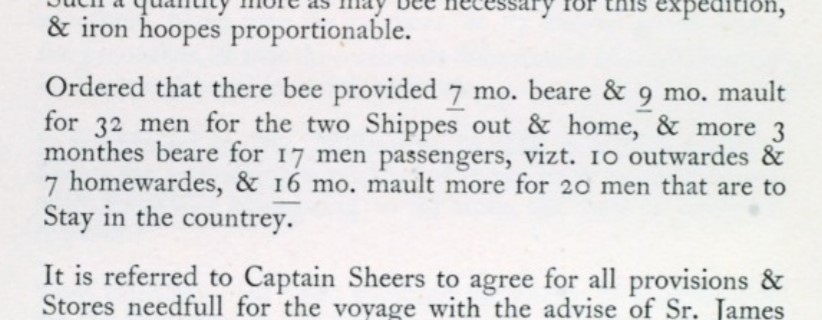 This post is a reworking and updating of a passage from that cult classic Ontario Beer: a Heady History…, the book Jordan and I published five years ago. I post this not only as a blatant reminder for Christmas giving, but as a look see to add to what we knew then about the role of beer in the years from 1660 to 1690. This was one of my favourite bits to research as it combined a number of heroic tales on the edge of Europe’s known universe.
This post is a reworking and updating of a passage from that cult classic Ontario Beer: a Heady History…, the book Jordan and I published five years ago. I post this not only as a blatant reminder for Christmas giving, but as a look see to add to what we knew then about the role of beer in the years from 1660 to 1690. This was one of my favourite bits to research as it combined a number of heroic tales on the edge of Europe’s known universe.
The conflict for control of what is now Ontario from the later 1600s was primarily between France and England. But the Dutch colony in what is now central New York on the Hudson River also sought its share through its alliance with the Mohawk nation until the 1660s. In the northeastern interior of the continent, events were part of what were known as the Beaver Wars. The beaver was destined for hat makers in Europe and at this point…
The fur trade depended on the labour of native people and on their centuries-old trading network… After being worn for a year, the pelts that made up the robes shed their long guard hairs, exposing the short hairs required for the felting process. Several hundred thousand used pelts, known as castor gras d’hiver would have been available annually…
Who knew European fancy hats depended on used Indigenous clothing? The beaver pelt was certainly a commodity recorded in the Company’s minutes. Anyway, after taking New Netherlands to the south of the French, England continued to expand its North American trading empire on Hudson Bay and James Bay through the establishment of “factories” or commercial settlements in the 1660s and 1670s. Beer was consistently included in the ships stores for the voyages to the factories and, apparently unlike the French, so was the means to brew beer as soon as the ship made shore.
 The English came well prepared with provisions, useful trade goods and even spoke the language – and as part of those preparations beer was clearly important to the early explorers. Perhaps their version of an astronaut’s roast beef dinner in a squeezable tube of three centuries later. The early ships’ crews exploring the eastern fringes of the Canadian Arctic in voyages in the 1570s and early 1600s considered their beer of great importance and even instrumental in survival. Driving further west in search of trade routes, in 1668-69 the crew of the Nonsuch were forced to over-winter on the James Bay coast and reported upon their return:
The English came well prepared with provisions, useful trade goods and even spoke the language – and as part of those preparations beer was clearly important to the early explorers. Perhaps their version of an astronaut’s roast beef dinner in a squeezable tube of three centuries later. The early ships’ crews exploring the eastern fringes of the Canadian Arctic in voyages in the 1570s and early 1600s considered their beer of great importance and even instrumental in survival. Driving further west in search of trade routes, in 1668-69 the crew of the Nonsuch were forced to over-winter on the James Bay coast and reported upon their return:
…they were environed with ice about 6 monethes first halting theire ketch on shore, and building them a house. They carried provisions on shore and brewd Ale and beere and provided against the cold which was their work…
Here is a YouTube vid showing the recreation of the ship, giving a sense of scale. It’s tiny. Note the reference to the two separate forms of fermented drink. Ale was likely unhopped or lightly hopped and brewed for early drinking while beer would have been hopped likely for longer keeping. None would have been considered an IPA as the sulfurous vomitous mess that later became known as Burtonized water was only being first explored as a tonic in a small alehouse in 1686.
After the return of the Nonsuch, Charles II granted a charter to the Hudson Bay Company in 1670. According to the Minutes of the Hudson Bay Company from the early 1670s, an order placed by the Hudson Bay Company’s London management for three grades of beer as well as malt and hops was recorded in the minutes noted on 16 February 1674:
John Raymond: By Severall quantities of Ship Beere at 40s p. Tonn Strong beere at 12s, 9d a barrell & Harbor Beere at 6s 6d p. barrell with Malt & Hopps dd. Capt. Gillam, Morris and Cole, £ 79.
A few months later, on 6 July 1674, the committee of the Hudson Bay Company directed payment to the same John Raymond £ 30 on account of “Beer and Malt. dd. on board the Prince Rupert.” The three grades of beer supplied and the means for crews to brew their own beer once the ships made landfall illustrates the various functions beer played in the life of the company. Ship beer sold in bulk not the barrel was the cheapest and weakest would have served as daily drink for the crew while at sea. The strong beer was reserved for the officers, as was apparently the case on Hudson’s voyage. The drink identified as “harbor beer” was sold at half the price of strong and may have been a middle strength beer for when the ship was at anchor. It’s actually the only time I have seen that grade of beer listed.
In 1674, the Hudson Bay Company planned 3 quarts of beer a day per man and shipped enough beer and malt to supply the trip there and back – and also to survive a winter. Twenty-seven tunns of beer and fifty-nine quarters of malt were purchased in 13 April 1674 for that season’s sailing of the 32 man expedition. Here are the instructions – and note that the plan included enough malt (or “mault”) for the 20 who were supposed to overwinter:
They were clearly planning to brew and that would require a total roughly 18,000 lbs of malt or enough malt to provide each man with a beer made from pound of malt a day. The details of all provisions can be found in the minutes from 14 April 1674.
Like the Nonsuch six years before, the crews of the Prince Rupert and Shaftsbury had to stay over in the winter of 1674-75 but were better prepared and provisioned for this possibility. It was too late too late in the season for the ships to return to England so arrangements were made for them to over winter in Rupert River and the crews were employed to cut timber to build houses for them as well as a brew-house and a bakery in the small fort. Their planning was not always successful. The beer and “winter-liquor” reportedly ran out by April 1674 at one Hudson’s Bay fort even if the stores of beer and malt shipped with the crews were significant.
The establishment of the northern English presence did not go unnoticed and clashes between the empires required feats of nearly unimaginable hardship and daring. When forces from New France struck at the forts on Hudson Bay in 1686, its soldiers walked north overland from the St. Lawrence Valley through hundreds of miles of forest before attacking and capturing Hudson Bay forts including Moose Factory at the mouth of the Moose River. The conflict was fairly civilized, with negotiations taking place over flagons of port wine. The return trip of the French forces by foot took four months just to reach the northern community at Temiskaming in December. The French detachment survived on five or six pounds of pork each as well as sprouted barley which had been “originally intended for brewing beer.” They probably found more than enough malt when they opened the brewery’s store rooms.
The French, temporary victors in this phase of Europe’s war for the New World’s north, survived the march home through the primeval winter forest by eating the brewing malt of the defeated English. Seventy or so years later, their control of northeastern North America was about to be lost. England and later Britain continued its trade via Hudson Bay but the greater focus of European efforts had long shifted away from the trade in woodland pelts. To the south, colonial farming plantations and entrepreneurial coastal towns were expanding in the early 1700s – which was accompanied by the first boom of commercial brewing in the Western Hemisphere.


A quick correction: The ship is the Nonsuch, not Nonesuch. The Nonsuch is probably my favourite part of the Manitoba Museum. It’s also the name of one my favourite local breweries, a stone’s throw away from the museum: https://www.nonsuch.beer/
See, I knew that. And I checked and rewrote it incorrectly based on an error I had made six years ago.